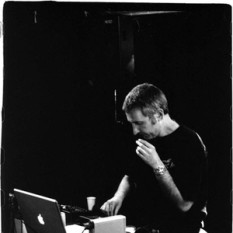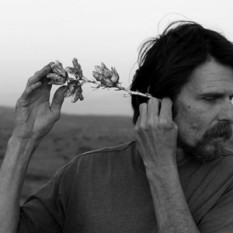For more than 15 years, the Yokohama based artist Toshiya Tsunoda has been releasing remarkable acoustic works into a world that he seems to hear like no one else. His CDs are the most idiosyncratic and rigorous to be found among the many field recording releases of recent years, though his work is just as easy to place in the sound art frame. His short tracks capture with dazzling clarity the acoustic characteristics of particular spaces. Often the focus narrows to a single phenomenon: wind whistling, the hum of an aluminium plate, or cicadas heard through a chink in a window frame.
The early Extract From Field Recording Archive series, conceived as a “catalogue of physical vibration”, contains one CD dedicated to standing waves, one to vibration in solids and another to vibration in air. Later CDs often combine field recordings and installation pieces. More recent work, such as his collaboration Familial Readings with the artist Luke Fowler, tends to have a more conceptual bent. Tsunoda has a background in visual art (he studied oil painting at university) and the idea of landscape permeates his practice. However, his pieces always raise questions about the perceptual process, the ways in which particular vibrational phenomena contour the subjective experience of time and space.
“The most important thing for my field work is the possibility of describing the experience of landscape,” he reports. “I want to know how to fix the experience of landscape. It’s a different method to using photography to fix it. We can see the outline of objects clearly in photographs. But when recording, things are not so clear and it is difficult to distinguish what vibrations travel in the place. It’s like a moving sculpture. I find many possibilities to connect with perception and recognition. So I cannot focus only on the aspect of sound or music in my field recordings. Even if it is not popular as an artwork, I am always pursuing fixing the scenery in my recording work.”
Tsunoda’s sonic artworks can be very direct: they draw the listener forcefully into a particular ambience or event or acoustic phenomenon. Short, pungent descriptive texts often accompany the works, amplifying what the recordist is seeking to achieve. In these, the relationship between ‘object’ and ‘observer’ is central. “This CD was made for the purpose of being heard,” he insists drily in one sleevenote. Human spatial awareness is addressed in these audio works, as the world becomes a vast network of interpenetrating vibrations, all of it open to the investigations of Tsunoda’s miniature microphones and contact mics.
This attentiveness to vibration often leads him to acoustic events that are not available to the human ear: a contact miked road surface, for example; the sound of air inside a glass bottle; or electromagnetic interference. Spaces that might have been dead, neutral, boring or forgotten are activated by Tsunoda’s mics, transformed into mobile, dynamic environments. In all this, the orientation of the recordist or listener in interpreting a certain environment is crucial.
“I think that the word ‘field’ of ‘field recording’ does not mean only the physical place,” he asserts. “Place or space always depends on one’s consideration. We can think of a gymnasium as a particular place. Also a public park is a space. We can call a town or woods a particular space. But what do we recognise in those spaces? The awareness of space changes with one’s intentionality. So my recording work mostly needs some explanation in the liner notes. The listener’s recognition of space or place will change if the sound is heard after reading it.
“If you think about it carefully, the activity of an actual space always moves,” he continues. If you put a contact mic on the ground or the wall of a space as I do, you can hear the standing wave that persists in the place. There is a complex mechanism there even if the wave seems simple. Probably all things – material, construction, temperature, humidity and so on – that concern the place might be a factor here. Place is always moving, like a sleeping cat.”
The mental processing of actual physical experience is what he is interested in, not just the conceptual content. In a contribution to the 1999 book Site Of Sound, edited by Brandon LaBelle and Steve Roden, he writes that he wants to approach, from various angles, what he calls “the relationship between phenomena and perception”. So, point of view – the perspective of the listener or recordist – becomes part of the subject matter of the artwork. “Listening to a recording should be a subjective experience,” he remarks. “Continuous moments. Like the view from the driver’s seat.” He sends a couple of sketches to illustrate his point. “Everyone gives importance to hearing,” he continues. “But I think it’s not the core problem. Hearing is like an entrance. If everybody thinks field recording work is only a strange kind of music, it might be so. However, I do not think so. I have my doubts about trying to listen to field recording only for the pleasure of the sound. For me, the sound is not necessarily important in field work. When I go out to record, it’s like meeting a familiar friend: ‘How are you today?’ Whether it’s boring or exciting doesn’t matter. The most interesting field recording for me, is often boring for most experimental music fans. This is a big problem! But I don’t care.”
Tsunoda’s work has often been issued on tiny labels. He himself runs two: Skiti (which has released work by Taku Sugimoto, Taku Unami and the Wandelweiser composer Manfred Werder) and the ‘private label’, edition.t (on which his collaborations with Luke Fowler and the Australian artist Michael Graeve have appeared). Yet he remains a public artist, interested in the circulation of ideas. In the 1990s, he was part of the WrK artists’ collective, along with Jio Shimizu, Hiroyuki Iida, Atsushi Tominaga and m/s – the group did lectures as well as exhibitions. More recently, from 2005–08, he co-edited with Taku Sugimoto and Mitsuhiro Yoshimura the free paper Santa, which published essays and reviews.
One CD that he is particularly fond of is Low Frequency Observed At Maguchi Bay, released on Hibari in 2007. It contains a rare example of processed sound in his work – the filtering out of almost the entire audio signal on half of the album. There are eight tracks, sourced from four contact mic field recordings. The odd-numbered tracks contain the original recordings, and the even numbered tracks replay the identical material with all sound above 20 Hz (ie the threshold of human hearing) removed. Listening to it, one becomes aware of something there but not-there, as the throbbing speakers seem to try to express something under extreme duress.
“Maguchi Bay is a very ordinary fishing bay in Japan, a quiet place,” he recounts. “But the place was mysterious for me. There are many piers and breakwaters at the bay. When a contact mic is attached to one of the smallest and oldest piers, a huge amplitude of very low frequency sound is spread there. It was an unusual case in my field work. I discovered the low frequency about ten years ago. The mysterious thing for me is that this low-frequency vibration doesn’t relate to any sound that one hears in the air. First, I thought that it was the effect of the wind shaking the pier. But then it happened when there was no wind. Then, I thought that the sound was the vibration of a distant ship resonating across the bay, bouncing off the hill and making itself felt under water in the bay. But this guess was wrong too, as it would have been possible to detect the sound with the air microphone. It was so mysterious.
“My next guess was that there was a cause at the bottom of the sea,” he continues. “So I asked a fisherman who lives there. His answer was that the seabed terrain was extremely rugged. The water currents at the bottom of the sea are terrible. So the low frequencies came from the seabed. It was the vibration of the underwater currents hitting the pier supports where they met the seabed. The low frequency that I observed is an essential feature of Maguchi Bay and it’s directly related to the structure of that place. It only became a fishing bay when a lot of breakwaters were built to calm down the terrible sea currents. So there is a local history that I became aware of through the low frequency. I came to love the place, which I’ve known since I was a child, more than before. This is an ideal example of my field work. However, this wonderful result is for only myself. The CD listener cannot know it, but it’s very important for me.
“Making the CD, I decided to delete everything over 20 Hz from the recording material,” he concludes. “There’s nothing to hear, but the loudspeaker moves on the even-numbered tracks. I wanted to give the listener the mysterious encounter with low frequencies that I had at Maguchi. The moving speaker is like a moving sculpture in the listener’s room. This is an example of my conceptual work.”
Prolonged exposure to Tsunoda’s work can make the whole world seem like a moving sculpture. A recent collaboration with percussionist Seijiro Murayama, released on Skiti, involved the pair visiting a Yokohama park and making over 80 recordings by placing mics inside a snare drum that is never actually played. The recordings simply reveal the changing sound of the space inside the drum in different conditions. As Tsunoda remarks in a statement for the Erstwords blog 18 months ago, “every space is constantly trembling”.
- Will Montgomery (http://thewire.co.uk/in-writing/essays/quiet-storms_toshiya-tsunoda) .
All albums
You can find information through the best music search engine - Muzlan.top 😊All materials on request "Toshiya Tsunoda" are available on page Toshiya Tsunoda
Yes of course. You can listen tracks on the page Toshiya Tsunoda
Yes of course. You can download tracks on the page Toshiya Tsunoda
This page is found by queries: Toshiya Tsunoda remix, Toshiya Tsunoda free download, Toshiya Tsunoda mp3 download, Toshiya Tsunoda flac, Toshiya Tsunoda song listen


